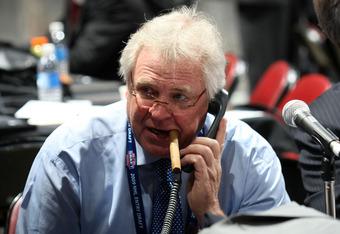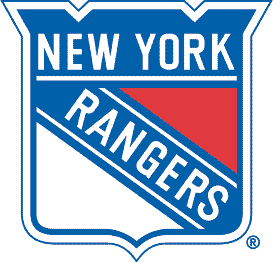 Despite a dearth of true talent under the Unrestricted Free Agent column heading, the 2011 off-season has brought a free agent spending spree like no other upon the NHL. (Be confident, true believers, Pucked in the Head is hard at work on a Seven Things about the Free Agent Firesale column. Well, maybe not ‘hard’ – and ‘work’ is a strong word – but trust me, we’re talking big game about maybe hashing something out over beer sometime before training camp. Or not, whatever.) Most agree that the New York Rangers were the undisputed winner, signing the cream of the crop Brad Richards to a nine-year, $60 million deal. And who’s to argue with Glen Sather, considering his wonderful track record with signing UFAs to big dollar contracts?
Despite a dearth of true talent under the Unrestricted Free Agent column heading, the 2011 off-season has brought a free agent spending spree like no other upon the NHL. (Be confident, true believers, Pucked in the Head is hard at work on a Seven Things about the Free Agent Firesale column. Well, maybe not ‘hard’ – and ‘work’ is a strong word – but trust me, we’re talking big game about maybe hashing something out over beer sometime before training camp. Or not, whatever.) Most agree that the New York Rangers were the undisputed winner, signing the cream of the crop Brad Richards to a nine-year, $60 million deal. And who’s to argue with Glen Sather, considering his wonderful track record with signing UFAs to big dollar contracts?
Well, us, that’s who. Since taking over the Blueshirts, the guy’s been an absolute disaster on July 1.
1.Scott Gomez had scored an average of 64 points per year with the New Jersey Devils in the first seven years of his career, winning the Calder Trophy as Rookie of the Year and two Stanley Cups along the way. He turned that consistent, tier-two play into a first rate deal on Free Agent Day in 2007. Slats rewarded him with big bucks, $51.5 million over seven years. Gomez responded with an average of… you guess it, 64 points over the first two years of the contract. Despite giving the Rangers precisely what they had paid for, fans reacted poorly – in 2009, Gomez was traded to the Montreal Canadiens for a cricket bat, three buckets of fried chicken and a box of chewing tobacco.
2. Chris Drury was signed on the same day as Gomez, with pretty much the same results. He’d put up career numbers in his contract season – a staggering 69 point-season, this guy had. Clearly worth a five-year, $35 million deal. Now, to be fair, here’s a guy who’s the only player in history to win both the Hobey Baker Memorial Award as the best player in collegiate hockey and the Calder as NHL Rookie of the Year. Drury’s pre-Rangers playoff numbers weren’t bad at all – he had 81 points in 114 post-season games when Sather inked him, and like Gomez, he came with a Stanley Cup on his resume (2001 with the Colorado Avalanche). But his point production in New York spiraled – he got 58 points in 2007-08 before being named the 25th team captain in Rangers history. He scored 56 points the following year, and 32 in the third year of his contract. In 2010-11, Drury played just 24 games, scored five points and discovered that his knee has a degenerative problem that may prematurely end his career. The Rangers have bought out the final year of that contract, but will see Drury count against the salary cap both this year and next.
3. Wade Redden was 31 years old when he signed as a UFA with the Rangers. He was a steady performer for the Senators, putting up 410 points over 11 seasons in Ottawa. He was a +150 during that span, so signing him for the Ranger blueline just had to be a slam dunk. Right? Uh, nope. Redden was ineffective in New York, marking just 26 and 14 points in the next two seasons, after which Sather buried him in the AHL. The good news? Buddy scored 42 points in 70 games with the Hartford Wolfpack / Connecticut Whale franchise. The bad news? Buddy is costing the Rangers $39 million over a six-year contract. In his two years with the Rangers, he received $162,500 for each point. With the Whale, he may have more productivity, but the franchise averages just over 5,600 in attendance. That many bums in seats don’t even pay for Redden’s contract at AHL prices. You can pay fifteen bucks to sit up against the glass at Whale games, for goodness’ sake. And for the next three seasons, barring unforeseen events, Redden the Six-Million Dollar Man will be right there in front of you.
 4. In the summer of 2002, Darius Kasparitus inked a six-year, $25 million deal with a $6 million signing bonus. A serviceable blueliner, he was hardly worth the kind of green flashed by the Rangers GM – in fact, Kaspar’s contract was one of the blue chip deals cited by the NHL to justify the 2004 lockout. And while it’s entirely Sather’s fault that he garnered that much money, the argument holds water. Sure, he was a conservative, defensive-minded defenseman, but Kasparitus had only topped 20 points once in his career, and that was in his rookie season. Is it any surprise, then, that he scored only 34 points in three and a half seasons with New York? That he spent two injury-plagued seasons on the farm team before calling it a career? Probably not. On a good note, while he was alternate captain of the Rangers, he initiated the routine of the team saluting the fans after every home win – a classy tradition now emulated by many teams around the league.
4. In the summer of 2002, Darius Kasparitus inked a six-year, $25 million deal with a $6 million signing bonus. A serviceable blueliner, he was hardly worth the kind of green flashed by the Rangers GM – in fact, Kaspar’s contract was one of the blue chip deals cited by the NHL to justify the 2004 lockout. And while it’s entirely Sather’s fault that he garnered that much money, the argument holds water. Sure, he was a conservative, defensive-minded defenseman, but Kasparitus had only topped 20 points once in his career, and that was in his rookie season. Is it any surprise, then, that he scored only 34 points in three and a half seasons with New York? That he spent two injury-plagued seasons on the farm team before calling it a career? Probably not. On a good note, while he was alternate captain of the Rangers, he initiated the routine of the team saluting the fans after every home win – a classy tradition now emulated by many teams around the league.
5. Sather seems to like overpaying guys in bunches. The same summer that he gave Kasparitus unspeakable amounts of money, he handed another 10-year veteran, ex-Devils forward Bobby Holik, $9 million per year over five years. NINE MILLION DOLLARS for a player who had never scored more than 65 points in a single season. Yes, he came with two Stanley Cup rings from the 1995 and 2000 New Jersey championship seasons, and had come just one win away from another one in 2001 when they lost in Game Seven to the Ray Bourque-led Avs. But I have to point to that NINE MILLION DOLLARS once again. This guy was given long-term Kovalbucks for Mariusz Czerkawski numbers. Imagine, if you will, Glen Sather sitting in his office, fingers steepled as his many assistants use interpretive dance to illustrate how much money the Rangers have to spend. “Why pay two 45-point men $4.5 million each, when I could give one 45-point player a single $9 million contract? Why, I ask you, why? Think of the paper we’ll save by printing fewer contracts!” Holik answered in kind, producing just 35 points in 64 games in the first year of the deal. “But they were gorgeous goals, you see? Quality, not quantity,” I’m sure he said. The year before the lockout, he brought that total up to 56 points, but you could tell his heart wasn’t into that kind of mass-produced work. The Rangers bought out the rest of the deal; Holik eventually bought Neverland Ranch, released a series of sub-par albums on his own label, and had extensive plastic surgery performed on his nose.
6. But hey, Rangers fans don’t just have free agency to lament. Glen Sather offered up some doozies in trades as well. While not technically a free agent signing, Sather’s decision to trade fan favourite Brian Leetch to the dirty rotten stinkin’ Toronto Maple Leafs most definitely deserves a spot on this list of boneheaded moves. Leetch had won the Calder Trophy as Rookie of the Year (1989), the Conn Smythe trophy as Playoff MVP (1994), two Norris Trophies as the NHL’s best defenseman (1992, 1997), numerous All-Star appearances, an Olympic silver medal (2002) and a World Cup of Hockey gold medal (1996), all while a member of the New York Rangers. At the 2004 trade deadline, Sather traded most of his veteran players away, including Leetch. He got in return for this player, who has since been named by the Hockey News as the Greatest Player in the History of the New York Rangers, these household names: Maxim Kondratiev (33 career NHL games, currently plays in the KHL), Jarkko Immonen (20 total NHL games, currently in the KHL), a 2004 first-round pick (who ended up being Lauri Korikoski, who played 58 games with the Rangers before being traded to Phoenix for a guy now in the KHL) and a 2005 second-rounder (Michael Sauer, who, to be fair scored 15 goals as a 22-year-old rookie with the Rangers last year). Brian Leetch, Hall of Famer and Rangers legend, finished his career with disappointing seasons in Toronto and Boston instead of bowing out a Blueshirt. Glen Sather, the only way you could have screwed this up more is if you traded him away on his anniversary, or somethi… wait, what? You completed this trade deadline deal on Brian Leetch’s 36th birthday? Slats, you are an idiot and a cad.
7. The 2011 frenzy saw far too many dollars thrown at far too many mediocre players. One of the only deals that makes sense, really, is the Rangers giving Brad Richards $60 million over nine years. He’s a solid offensive talent and a leader both on and off the ice. He’s a humble guy, one who’s won a Cup and a Conn Smythe, and one who has ties in the community anywhere he goes. The Brad Richards Foundation helps children with chronic and terminal illness in both Tampa Bay and Dallas; he does continuous work in his home province of Prince Edward Island. You can only assume he will set down some similar charity roots in the Big Apple. Unlike most of the shenanigans Sather has gotten up to since being crowned King of New York, there’s not much downside to this deal going in. But you can’t put anything past Slats – he’s an evil genius. There must be some disastrous snag somewhere that we’re not aware of just yet. Give Sather time, and he’ll find a way to make this deal stink like a PEI fishing trawler.
Want more Seven Things? Check out our archive of Pucked in the Head columns here. Or jump to Jason’s contributions at The Hockey Writers website. {jcomments on}
